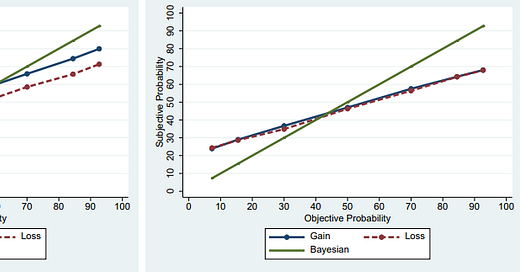It is by now well established that investors who go through traumatic market experiences like the Great Depression or the inflation of the 1970s become scarred by these experiences for the rest of their lives. Similarly, I think the market environment when you start your career as an investor plays an important role in shaping how you invest. And a new study has shown how this mechanism may work.
The research was interested in the assessment of good and bad information about stocks and how likely they found based on the received information that the share price would go up or down. 680 professional investors (wealth managers, fund managers, and investment bankers) were primed with a stock chart that showed that the share price of a company was going up or down. Then new information about the company was disclosed and the investors were asked if they would buy or sell the stock. And how likely they found the share price would rise or drop.
The chart below shows the response of the investors to good and bad news about the stock and how likely they thought the share price would increase.
Subjective probabilities for share price trends depend on the market environment
Source: Niu et al. (2022)
In the left panel, the three lines show the probability investors give to good news leading to rising share prices and bad news leading to losses when they have been primed with a positive market environment. That is the investors have learned about the stock in a bull market. The green line, by the way, is the rational investor whose subjective assessment of the probability of gains and losses equals the objective probability.
Both the blue and red lines for good and bad news demonstrate the human bias towards putting a higher subjective probability on very unlikely events and underweighting very likely events. That is one of the reasons of why Cassandras who go on about catastrophes are so popular. Cassandras talk about extremely unlikely events that feel like they are more likely to happen than they really are.
Note in the left panel above that investors who learned about the stock in a bull market are systematically more likely to expect the share price to rise when good news is released than the share price to drop when bad news is released. These investors are overoptimistic about the stock because their experience is one of the stocks going up most of the time.
Now look at the right panel which shows the subjective probabilities associated with good and bad news for investors who have learned about the stock in a bear market. The red line is practically the same as in the left panel, meaning that the subjective probability investors put on the share price going down after bad news is the same whether they have learned about the stock in a bull or bear market. But what disappears for investors who have learned about a tock in a bear market is the overoptimism in response to good news. Investors who have learned about a stock in a bear market show no overoptimism and no inherent bias towards being bullish stocks. And it is this lack of overoptimism why investors who have learned their trade in a bear market have slightly better performance on average than investors who have learned their trade in a bull market, as I have discussed here.





"And it is this lack of overoptimism why investors who have learned their trade in a bear market have slightly better performance on average than investors who have learned their trade in a bear market"
The latter would be 'bull market', then.
As always, so interesting! Thanks for sharing your reading with everyone on this blog.